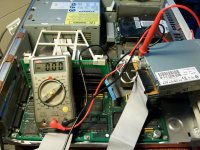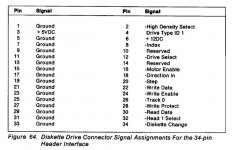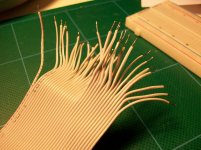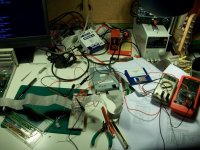ajcc
Experienced Member
Hi guys!
I got myself an IBM PS/2 Model 30 with a 10 MHz 286er in it. I've been having quite a fight with it recently and now I'm completely stuck.
The ALPS diskette drive that came with the computer had its capacitors leak and ruin the circuit, so it doesn't work. I thought it would just have a standard 3.5" diskette drive inside, but there was no power connector?
Trying to find an answer I found these two threads: Reborn IBM PS2 30 286 and IBM PS/2 Model 30 (8530-002). Sadly I was discouraged by the comments and decided to put my voltmeter to the board and see if they were sound. Pin 4 isn't Ground so I wasn't sure... if it had been you could have just put the four wires into the power connector neatly, not tearing out single strands of wire.
Anyway, there doesn't seem to be a Model 30-286 service manual out there on the Internet. But I found out the the P70 had the same ALPS diskette drive in it (searching the IBM part number: 72X6068 ), so I finally found the correct pin-out of the diskette drive! (Note that there's a 40-pin connector on the motherboard, which seem to have extra pins for power, not sure).
I found the PS/2 Model P70 Technical Reference on the bitsavers ftp.
On pages 41:
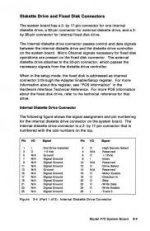
And page 42:
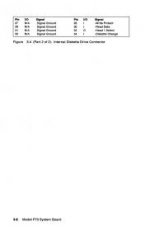
There is the pin out.
Then after fighting and destroying a couple of IDC connectors, I had an adapter. It didn't work! So I decided to test every diskette drive I had, still didn't work... I checked the wiring, checked the voltages, everything was fine, the 5V line didn't drop in voltage during read... maybe all my diskette drives are broken?
Sad and ready to just give up, I realized I didn't try a 720kB diskette. That did work! Trying to run format A: crashed the computer though, might be a broken DOS, I don't know. I could even write a file onto the diskette.
So, now I wonder. How do I get it to see my 1.44MB diskette drive?, the /Density Low or High doesn't seem to be used on any of my drives. It's always 5V on the PS/2 as well, so maybe it isn't used? Now the problem is that the Advanced Diagnostics diskette is a 1.44MB image, and I can't boot 1.44MB diskettes.
I'm stuck
I got myself an IBM PS/2 Model 30 with a 10 MHz 286er in it. I've been having quite a fight with it recently and now I'm completely stuck.
The ALPS diskette drive that came with the computer had its capacitors leak and ruin the circuit, so it doesn't work. I thought it would just have a standard 3.5" diskette drive inside, but there was no power connector?
Trying to find an answer I found these two threads: Reborn IBM PS2 30 286 and IBM PS/2 Model 30 (8530-002). Sadly I was discouraged by the comments and decided to put my voltmeter to the board and see if they were sound. Pin 4 isn't Ground so I wasn't sure... if it had been you could have just put the four wires into the power connector neatly, not tearing out single strands of wire.
Anyway, there doesn't seem to be a Model 30-286 service manual out there on the Internet. But I found out the the P70 had the same ALPS diskette drive in it (searching the IBM part number: 72X6068 ), so I finally found the correct pin-out of the diskette drive! (Note that there's a 40-pin connector on the motherboard, which seem to have extra pins for power, not sure).
I found the PS/2 Model P70 Technical Reference on the bitsavers ftp.
On pages 41:

And page 42:

There is the pin out.
Then after fighting and destroying a couple of IDC connectors, I had an adapter. It didn't work! So I decided to test every diskette drive I had, still didn't work... I checked the wiring, checked the voltages, everything was fine, the 5V line didn't drop in voltage during read... maybe all my diskette drives are broken?
Sad and ready to just give up, I realized I didn't try a 720kB diskette. That did work! Trying to run format A: crashed the computer though, might be a broken DOS, I don't know. I could even write a file onto the diskette.
So, now I wonder. How do I get it to see my 1.44MB diskette drive?, the /Density Low or High doesn't seem to be used on any of my drives. It's always 5V on the PS/2 as well, so maybe it isn't used? Now the problem is that the Advanced Diagnostics diskette is a 1.44MB image, and I can't boot 1.44MB diskettes.
I'm stuck

